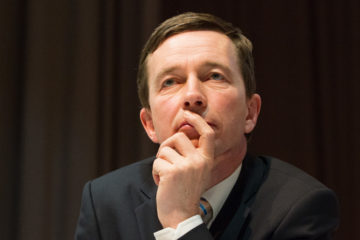In January, Pope Francis visited Chile and Peru in a trip which was overshadowed by controversy concerning sexual abuse cases and consequent cover-ups by the Church in these countries. However, the papal visit was also notable for another reason, that being the changing religious landscape in Latin America, the Pope’s continent of origin. For centuries the Catholic Church had a virtual religious monopoly in the region, but since the 1970s the percentage of the population who consider themselves Catholic has steadily declined. At the same time, the percentage of those who identify as either Protestant or non-religious has increased considerably.
Latin America has long been seen as a bastion of Catholicism, with the religion being a key unifying component of Latin American identity and culture. The continent is home to the largest population of the faithful on Earth, totalling approximately 40% of all Catholics worldwide and encompassing the two most Catholic nations in terms of population, Brazil and Mexico. Nonetheless, according to Pew Research, whereas an estimated 92% of Latin Americans identified themselves as Catholic in 1970, only 69% did so in 2014. In 2017 Latinobarometro found this figure to be a mere 59%. This decrease, although common across all countries in the region, is not uniform in its extent. To take countries at the opposite ends of the spectrum, less than half of the population of Honduras is Catholic, compared to nearly 9 out of 10 Paraguayans. In order to explain this downward trend, commentators have turned to two corresponding religious tendencies: the rising percentage of both the non-religious and Protestant population.
Starting with the religiously unaffiliated, the portion of atheist, agnostic or non-religious Latin Americans rose from fewer than one in twenty in 1995 to nearly one fifth in 2017. In some countries, the reasons behind such high levels of non-religion are historic. For example, Uruguay, the least religious country in the continent, where 41% of the population are unaffiliated, has a unique history of secularism. Uruguay had a relatively small indigenous population at the time of the Spanish colonisation, so there were fewer people to convert and consequently the Church was less influential.
The second challenge to Catholicism comes from increasing competition it faces in the Latin American religious economy, most significantly from Protestantism. Protestants in 2017 represented one in five Latin Americans, up from an estimated one in twenty in 1970, with Pentecostalism being the most popular form. This growth is in large part the result of former Catholics migrating to the Protestant church, with over half of all Protestants having been baptised as Catholics. Pew Research has investigated the motivations cited by former Catholics for their conversion, the most popular reason being a desire to seek a personal connection with God (81%) which is emphasised more heavily in Protestant churches. Second is the style of worship at their new church (69%) which, in Pentecostal churches, differs from traditional Catholicism by including rituals associated with the ‘gifts of the Holy Spirit’ such as speaking in tongues, spiritual healing and even exorcisms.
Furthermore, Andrew Chesnut, professor of Religious Studies at Virginia Commonwealth University, argues that Protestant churches have integrated better into the local culture than the Catholic Church. This is demonstrated both by the type of music heard in ceremonies and the fact that preachers are more likely to be local and of the same socioeconomic status as their parish. The third motivation stated by converts was a desire for a greater emphasis on morality (60%). Pew Research finds that Catholics are more likely to have more liberal attitudes towards social issues such assame-sexx marriage, abortion and consumption of alcohol than Protestants. The fourth most popular incentive was that their new church provides more help to members (59%) which could relate to practices of divine healing. Finally, outreach by their new church was also a motivating factor (58%). The evangelising missions of Protestant churches have successfully utilised technology to popularise religion, beginning with radio from the 1950s to television from the 1990s.
The threat posed to the Catholic Church by the growth of Protestantism is quantitatively more concerning than corresponding increases in the non-religiously affiliated population. Nonetheless, it indicates that among Latin Americans, there remains an overwhelming appetite for religion, which the Catholic Church could, in theory, satisfy.
CCR has also imitated Pentecostalist efforts to popularise religion. For example, the most famous CCR priest is the Brazilian Marcelo Rossi who holds ‘mega masses’ and was nominated for a Latin Grammy. The CCR movement has grown considerably, according to Pew Research, across Latin America with at least one in five Catholics in 2014 describing themselves as charismatics, with charismatics concentrated mainly in Brazil, Colombia and Mexico. The potential of CCR to renew Catholicism in Latin America has been recognised especially by Pope Francis, who as the first Pope to attend an annual CCR convocation called the movement a ‘great force’ for the Church.
The religious landscape in Latin America has been shaken up in the last fifty years and Catholicism is no longer the only game in town. Instead it finds itself competing within a pluralist marketplace against Protestant churches and non religion. Although over this period it has experienced a steady decline of its followers in percentage terms, future deterioration is not inevitable. The example of CCR demonstrates that should the Church adapt to the wants of the still largely religious Latin American population, it may yet stem the hemorrhaging of its flock or even win some of them back.
Sources:
Pew Research: assets.pewresearch.org/wp-content/uploads/sites/11/2014/11/Religion-in-Latin-America-11-12-PM-full-PDF.pdf
Latinobarometro: www.latinobarometro.org/latNewsShow.jsp


